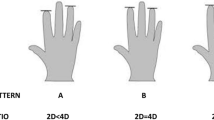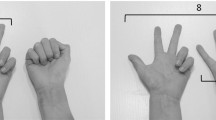Abstract
In a sample from the Biscaian Basque population, we studied the incidence of pattern types in fingers and the parallelism between the frequencies for the orientations of whorls (Wr, Ws, Wu) and the other pattern types (Lr, A, Lu). We reaffirm the importance of clarifying pattern types according to their orientation, which is of general use in the case of loops but less easily applied to whorls.
Similar content being viewed by others
References
Dalhberg A.A. 1945.The Changing Dentition of Man. Journal of the American Dentist Association, 32: 676–690.
Galton F. 1982.Fingerprint. London: MacMillan.
Holt S.B. 1968.The Genetics of dermal ridges. Springfield, Illinois: Ch. Thomas Publ.
Karlin S., Chakraborty R., Williams P.T. and Mathews S. 1983.Structured exploratory data analysis (SEDA) of finger ridge count inheritance: I, Mayor gene index, midparental correlation, and offspring-between-parents function in 125 South Indian families. American Journal of Human Genetics, 62: 377–396.
Kobyliansky E., Micle S., Arensburg B. and Nathan H. 1979.Finger dermatoglyphic characteristics in Israel males. Zeitschrift für Morphologie und Anthropologie, 71: 322–328.
Malhotra K.C., Chakraborty R., Bhanu B.V. and Fulmali P.M. 1980.Variations on dermal ridges in nine population groups of Maharashtra, India. I. Intra- and interpopulation diversity. Human Heredity, 30: 307–315.
Micle S., Kobyliansky E., Arensburg B. and Nathan H. 1982.Whorl patterns on fingertips: their classification as based on the proportionality of their ulnar and radial ridge counts. Journal of Human Evolution, 11: 487–491.
Mulvihill M.H. and Smith D.W. 1969.The genesis of dermatoglyphics. Journal of Pediatry, 75: 579–589.
Penrose L.S. 1968.Memorandum on dermatoglyphic nomenclature. Birth Defects, Original Article Series, 4 (3): 1–13.
Roberts D.F. and Coope E. 1975.Components of variation in a multifactorial character: a dermatoglyphic analysis. Human Biology, 47: 169–188.
Roberts D.F. 1979.Dermatoglyphics and human genetics. Birth Defects, Original Article Series, 6 (15): 475–494.
Siervogel R.M., Roche A.F. and Roche E.M. 1978.Developmental fields for digital dermatoglyphics traits as revealed by multivariate analysis. Human Biology, 50: 541–556.
Author information
Authors and Affiliations
Rights and permissions
About this article
Cite this article
Arrieta, M.I., Gonzalez, E., Pastor, G. et al. Parallelism between the frequencies of differently oriented whorls and other pattern types in Basque population. Int. J. Anthropol. 1, 5–8 (1986). https://doi.org/10.1007/BF02443901
Issue Date:
DOI: https://doi.org/10.1007/BF02443901




